Quantifying the Spatiotemporal Response of Winter Wheat Yield to Climate Change in Henan Province via APSIM Simulations
Abstract
1. Introduction
2. Materials and Methods
2.1. Study Area
2.2. Data Collection and Processing
2.2.1. Quantifying Long-Term Trends of Meteorological Elements with Climate Tendency Rate
2.2.2. Agricultural Statistical Data
2.2.3. Data Integration and Spatial Analysis
2.2.4. Correlation Analysis
2.3. APSIM Model Configuration and Calibration
2.3.1. Model Setup and Parameterization
2.3.2. Model Calibration and Accuracy Validation
3. Results
3.1. Spatiotemporal Dynamics of Agroclimatic Resources During the Winter Wheat Growing Season
3.1.1. Interannual Trends of Meteorological Factors
3.1.2. Spatial Distribution Characteristics of Meteorological Factors
3.2. Spatiotemporal Distribution Characteristics of Winter Wheat Yield
3.2.1. Temporal Variation of Actual Yield and Detrended Climate-Driven Yield
3.2.2. Spatial Distribution of Actual Yield and Climate-Driven Yield
3.3. Winter Wheat Yield Analysis and Prediction Under Future Climate Scenarios
3.3.1. Calibration and Validation of APSIM Model
3.3.2. Winter Wheat Potential Yield Prediction Under Future Climate Scenarios
4. Discussion
4.1. Interpretation of Agroclimatic Resource Variations and Their Biophysical Implications
4.2. Drivers of Spatial Yield Variability and Adaptive Capacity
4.3. Future Yield Projections and Knowledge Gaps in Climate Change Impact Assessment
5. Conclusions
- (1).
- Regional-scale analysis establishes accumulated temperature as the primary driver of winter wheat yield variation, significantly outweighing precipitation and solar radiation. This finding elucidates the physiological mechanism of heat accumulation under warming-drying trends. Observed phenological shifts, particularly growth period extension and negative correlations with water/sunshine availability, require implementing adapted cultivars and modified cultivation practices to maintain productivity under evolving climatic conditions.
- (2).
- Historical yield simulations demonstrate significant climate resilience in current agricultural management systems, manifested through stable production across most regions and a marked decline in the frequency of climate-induced crop failure years. This trend highlights the crucial role of technological advances and management optimization in mitigating climate risks. Future scenario projections further confirm substantial yield increases in Henan’s major crop-producing areas—including Zhengzhou, Xinxiang, and Luoyang—indicating positive adaptation potential under medium-emission scenarios.
Author Contributions
Funding
Data Availability Statement
Acknowledgments
Conflicts of Interest
References
- Zheng, J.; Wang, W.; Wang, W.; Cui, T.; Chen, S.; Xu, C.; Enge, B. FACE-ing Climate Change: Propagation of Risks and Opportunities for Cropping Systems in Mid-High-Latitude Regions: A Case Study between U.S. and China Corn Belts. Agric. Syst. 2024, 220, 104087. [Google Scholar] [CrossRef]
- Livingston, J.E.; Rummukainen, M. Making Policy-Relevant Knowledge in the IPCC Special Report on 1.5 Degrees: An Analysis of Reviewer Comments. Environ. Sci. Policy 2023, 147, 305–314. [Google Scholar] [CrossRef]
- Zhang, W.; Furtado, K.; Wu, P.L.; Zhou, T.; Chadwick, R.; Marzin, C.; Rostron, J.; Sexton, D. Increasing Precipitation Variability on Daily-to-Multiyear Timescales in a Warmer World. Sci. Adv. 2021, 7, eabf8021. [Google Scholar] [CrossRef]
- Campos-Avelar, I.; Montoya Martínez, A.C.; Morales Sandoval, P.H.; Cervantes Enriquez, É.P.; Parra Cota, F.I.; de los Santos Villalobos, S. Impact of Climate Change on Food Security and Plant Disease Management. In Climate Change and Agricultural Ecosystems, 2nd ed.; Woodhead Publishing: Cambridge, UK, 2025; pp. 331–367. [Google Scholar] [CrossRef]
- Pérez-Lucas, G.; Navarro, G.; Navarro, S. Adapting Agriculture and Pesticide Use in Mediterranean Regions under Climate Change Scenarios: A Comprehensive Review. Eur. J. Agron. 2024, 161, 127337. [Google Scholar] [CrossRef]
- Cao, Y.; Qiu, X.; Kang, M.; Zhang, L.; Lu, W.; Liu, B.; Tang, L.; Xiao, L.; Zhu, Y.; Cao, W.; et al. Evaluating the Impacts of Climatic Factors and Global Climate Change on the Yield and Resource Use Efficiency of Winter Wheat in China. Eur. J. Agron. 2024, 159, 127295. [Google Scholar] [CrossRef]
- Challinor, A.J.; Watson, J.; Lobell, D.B.; Howden, S.M.; Smith, D.R.; Chhetri, N. A Meta-Analysis of Crop Yield under Climate Change and Adaptation. Nat. Clim. Chang. 2014, 4, 287–291. [Google Scholar] [CrossRef]
- Yao, Y.; Li, G.; Lu, Y.H.; Liu, S. Modelling the Impact of Climate Change and Tillage Practices on Soil CO2 Emissions from Dry Farmland in the Loess Plateau of China. Ecol. Model. 2023, 478, 110276. [Google Scholar] [CrossRef]
- Jiang, T.; Wang, B.; Duan, X.N.; Liu, D.L.; He, J.; He, L.; Jin, N.; Feng, H.; Yu, Q. Prioritizing Agronomic Practices and Uncertainty Assessment under Climate Change for Winter Wheat in the Loess Plateau, China. Agric. Syst. 2023, 212, 103770. [Google Scholar] [CrossRef]
- Innes, P.; Tan, D.; Van Ogtrop, F.; Amthor, J. Effects of High-Temperature Episodes on Wheat Yields in New South Wales, Australia. Agric. For. Meteorol. 2015, 208, 95–107. [Google Scholar]
- Lenka, N.K.; Lenka, S.; Yashona, D.S.; Jat, D. Elevated Temperature and Low Nitrogen Partially Offset the Yield, Evapotranspiration, and Water Use Efficiency of Winter Wheat under Carbon Dioxide Enrichment. Agric. Water Manag. 2021, 250, 106856. [Google Scholar] [CrossRef]
- Sun, H.; Wang, Y.; Wang, L. Impact of Climate Change on Wheat Production in China. Eur. J. Agron. 2024, 153, 127066. [Google Scholar] [CrossRef]
- Li, Y.; Tao, F. Interactions of Genotype, Environment and Management on Wheat Traits and Grain Yield Variations in Different Climate Zones across China. Agric. Syst. 2022, 203, 103521. [Google Scholar] [CrossRef]
- Erokhin, V.; Esaulko, A.; Pismennaya, E.; Golosnoy, E.; Vlasova, O.; Ivolga, A. Combined Impact of Climate Change and Land Qualities on Winter Wheat Yield in Central Fore-Caucasus: The Long-Term Retrospective Study. Land 2021, 10, 1339. [Google Scholar] [CrossRef]
- Farrell, A.D.; Deryng, D.; Neufeldt, H. Modelling Adaptation and Transformative Adaptation in Cropping Systems: Recent Advances and Future Directions. Curr. Opin. Environ. Sustain. 2023, 61, 101265. [Google Scholar] [CrossRef]
- Chen, Y.; Liang, K.; Cui, B.; Hou, J.; Rosenqvist, E.; Fang, L.; Liu, F. Incorporating the Temperature Responses of Stomatal and Non-Stomatal Limitations to Photosynthesis Improves the Predictability of the Unified Stomatal Optimization Model for Wheat under Heat Stress. Agric. For. Meteorol. 2025, 362, 110381. [Google Scholar] [CrossRef]
- Wang, D.; Guo, M.; Liu, S.; Li, Y.; Dong, Q.; Gong, X.; Ge, J.; Wu, F.; Feng, H. Spatiotemporal Evolution of Winter Wheat Planting Area and Meteorology-Driven Effects on Yield under Climate Change in Henan Province of China. Plants 2024, 13, 2109. [Google Scholar] [CrossRef]
- Feng, X.; Wu, F.; Zai, S.; Wang, D.; Zhang, Y.; Chai, Q. Characteristics and Impacts of Water-Thermal Variation on Grain Yield in the Henan Province, China, on Multiple Time Scales. Agronomy 2023, 13, 429. [Google Scholar] [CrossRef]
- Duan, R.; Huang, G.; Li, Y.; Zhou, X.; Ren, J.; Tian, C. Stepwise Clustering Future Meteorological Drought Projection and Multi-Level Factorial Analysis under Climate Change: A Case Study of the Pearl River Basin, China. Environ. Res. 2021, 196, 110368. [Google Scholar] [CrossRef]
- Wu, J.; Shen, H.; Yang, Y.; Zhao, J.; Ding, T.; Zhao, W. Optimizing Winter Wheat Varieties for Yield and Net Ecosystem Productivity under Climate Change in the North China Plain. Eur. J. Agron. 2025, 169, 127675. [Google Scholar] [CrossRef]
- Tao, F.L.; Xiao, D.P.; Zhang, S.; Zhang, Z.; Rötter, R.P. Wheat Yield Benefited from Increases in Minimum Temperature in the Huang-Huai-Hai Plain of China in the Past Three Decades. Agric. For. Meteorol. 2017, 239, 1–14. [Google Scholar] [CrossRef]
- Wang, D.; Liu, S.; Guo, M.; Cheng, Y.; Shi, L.; Li, J.; Yu, Y.; Wu, S.; Dong, Q.; Ge, J.; et al. Optimizing Nitrogen Fertilization and Irrigation Practices for Enhanced Winter Wheat Productivity in the North China Plain: A Meta-Analysis. Plants 2025, 14, 1686. [Google Scholar] [CrossRef]
- Kadiyala, M.D.M.; Nedumaran, S.; Singh, P.; Chukka, S.; Irshad, M.A.; Bantilan, M.C.S. An Integrated Crop Model and GIS Decision Support System for Assisting Agronomic Decision Making under Climate Change. Sci. Total Environ. 2015, 521–522, 123–134. [Google Scholar] [CrossRef]
- Mohamad, M.A. An Innovative Intelligent System Based on Remote Sensing and Mathematical Models for Improving Crop Yield Estimation. Inf. Process. Agric. 2019, 6, 316–325. [Google Scholar] [CrossRef]
- Wang, X.Q.; Jia, Z.K.; Li, Y.B. Research on Wheat Production Potential of Henan Based on AEZ Modeling. J. Northwest A&F Univ. (Nat. Sci. Ed.) 2018, 26, 547–558. [Google Scholar] [CrossRef]
- Yang, X.; Li, Z.; Cui, S.; Cao, Q.; Deng, J.; Lai, X.; Shen, Y. Cropping System Productivity and Evapotranspiration in the Semiarid Loess Plateau of China under Future Temperature and Precipitation Changes: An APSIM-Based Analysis of Rotational vs. Continuous Systems. Agric. Water Manag. 2020, 229, 105959. [Google Scholar] [CrossRef]
- Lin, H.; Tang, J.; Wang, S.; Wang, S.; Dong, G. Deep learning downscaled high- resolution daily near surface meteorological datasets over east asia. Sci. Data 2023, 10, 890. [Google Scholar] [CrossRef]
- Wang, D.L.; Li, Y.B.; Zhang, B.B.; Jiang, T.C.; Wu, S.Y.; Wu, W.J.; Li, Y.; Liu, D.L.; He, J.Q.; Dong, Q.G.; et al. Exploring the Evolution of Winter Wheat Production and Its Response to Climate Change under Varying Precipitation Years on the Loess Plateau of China. Agric. Water Manag. 2025, 309, 109335. [Google Scholar] [CrossRef]
- Zhang, L.L. Analysis of Winter Wheat Yield Gap and Water-Nitrogen Use Efficiency on the Loess Plateau. Ph.D. Thesis, Chinese Academy of Sciences, Beijing, China, 2019. [Google Scholar]
- Gong, J.J.; Liu, Z.J.; Zhu, G.X.; Shi, D.Y.; Zhang, Z.T.; Fu, Z.Z.; Lu, X.M.; Qu, H.H.; Yang, X.G. Impacts of Climate Change on Maize Productivity in China from 2015 to 2100 Based on the APSIM Model. Trans. Chin. Soc. Agric. Eng. 2023, 39, 167–178. [Google Scholar]
- Juez, C.; Garijo, N.; Nadal-Romero, E.; Vicente-Serrano, S.M. Wavelet analysis of hydro-climatic time-series and vegetation trends of the Upper Aragón catchment (Central SpanishPyrenees). J. Hydrol. 2022, 614 Pt B, 128584. [Google Scholar]
- Sun, H.W.; Ma, J.H.; Wang, L. Simulation of Suitable Planting Areas for Winter Wheat on the Loess Plateau Under Future Climate Change Scenarios Using the APSIM Model. J. Triticeae Crops 2021, 41, 771–782. [Google Scholar]
- Wu, J.J.; Gu, Y.H.; Wang, N.; Shen, H.Z.; Ma, X.Y. Risk Probability Assessment of Winter Wheat Net Primary Productivity Loss and Its Driving Factors in the North China Plain. Field Crops Res. 2023, 300, 109013. [Google Scholar] [CrossRef]
- Zhou, W.M.; Ata-Ul-Karim, S.T.; Kato, Y.; Liu, H.Y.; Wang, K.C. Exploring the Climate Signal in the Variation of Winter Wheat Quality Records in the North China Plain. Agric. For. Meteorol. 2025, 369, 110567. [Google Scholar] [CrossRef]
- Jiang, L.F. Response of Winter Wheat Phenology to Climate Change and Its Impact on Yield in Henan Province. Master’s Thesis, Chang’an University, Xi’an, China, 2022. [Google Scholar]
- Tan, K.Y.; Fang, S.B.; Ren, S.X. Experimental Study on the Impact of Warming on Winter Wheat Production in North China. Acta Meteorol. Sin. 2012, 70, 902–908. [Google Scholar]
- Xu, Z.X.; Su, H.B.; Jiang, X.D.; Ye, X.F.; Zeng, Y. Impacts of Climate Warming on Growth, Yield and Quality of Winter Wheat. Chin. Agric. Sci. Bull. 2020, 36, 101–105. [Google Scholar]
- Li, M.; Lai, C.J.; Li, J.P.; Li, J.C.; Zhu, Y.L.; Song, Y.H. Effects of High Temperature during Grain Filling Stage on Physiological Characteristics of Source Leaves and Grain Sinks in Winter Wheat. J. Triticeae Crops 2022, 42, 1567–1574. [Google Scholar]
- Peltoniemi, K.; Velmala, S.; Lloret, E.; Ollio, I.; Hyvönen, J.; Liski, E.; Brandt, K.K.; Campillo-Cora, C.; Fritze, H.; Iivonen, S.; et al. Soil and Climatic Characteristics and Farming System Shape Fungal Communities in European Wheat Fields. Agric. Ecosyst. Environ. 2024, 370, 109035. [Google Scholar] [CrossRef]
- Fan, X.; Schütze, N. Assessing Crop Yield and Water Balance in Crop Rotation Irrigation Systems: Exploring Sensitivity to Soil Hydraulic Characteristics and Initial Moisture Conditions in the North China Plain. Agric. Water Manag. 2024, 300, 108897. [Google Scholar] [CrossRef]
- Gao, Z.; Wang, C.; Zhao, J.; Wang, K.; Shang, M.; Qin, Y.; Bo, X.; Chen, F.; Chu, Q. Adopting Different Irrigation and Nitrogen Management Based on Precipitation Year Types Balances Winter Wheat Yields and Greenhouse Gas Emissions. Field Crops Res. 2022, 280, 108484. [Google Scholar] [CrossRef]
- Lu, F.; Meng, J.; Cheng, B. How Does Improving Agricultural Mechanization Affect the Green Development of Agriculture? Evidence from China. J. Clean. Prod. 2024, 472, 143298. [Google Scholar] [CrossRef]
- Song, H.; Li, X.; Xin, L.; Wang, X. Improving Mechanization Conditions or Encouraging Non-Grain Crop Production? Strategies for Mitigating Farmland Abandonment in China’s Mountainous Areas. Land Use Policy 2025, 149, 107421. [Google Scholar] [CrossRef]
- Malakouti, S.M. Utilizing Time Series Data from 1961 to 2019 Recorded Around the World and Machine Learning to Create a Global Temperature Change Prediction Model. Case Stud. Chem. Environ. Eng. 2023, 7, 100312. [Google Scholar]
- Elsayed, M.L.; Elkot, A.F.; Noreldin, T.; Richard, B.; Qi, A.; Shabana, Y.M.; Saleh, S.M.; Fitt, B.D.L.; Kheir, A.M.S. Optimizing Wheat Yield and Water Productivity under Water Scarcity: A Modeling Approach for Irrigation and Cultivar Selection across Different Agro-Climatic Zones of Egypt. Agric. Water Manag. 2025, 317, 109668. [Google Scholar] [CrossRef]
- Zheng, H.; Lu, J.; He, H.; Wu, Y.; He, M.; Cheng, D.; Yao, Z.; Gomez, C. Quantifying Spatial Heterogeneity and Driving Mechanisms of Water-Energy-Food Coordination in the Yellow River Basin: A Hybrid Framework Approach. Energy 2025, 334, 137757. [Google Scholar] [CrossRef]
- Wang, D.; Guo, M.; Li, J.; Wu, S.; Cheng, Y.; Shi, L.; Liu, S.; Ge, J.; Dong, Q.; Li, Y.; et al. Impact of climate change on the winter wheat productivity under varying climate scenarios in the Loess Plateau: An APSIM analysis (1961–2100). Agronomy 2024, 14, 2609. [Google Scholar] [CrossRef]
- Bai, Y.; Liu, L.; Li, H.; Huang, G. Synergistic Interactions of CO2 Fertilization with Water, Heat, and Nitrogen under Climate Change: Evidence from Maize, Rice, and Wheat. Field Crops Res. 2025, 332, 110016. [Google Scholar] [CrossRef]
- Ding, Z.; Ali, E.F.; Elmahdy, A.M.; Ragab, K.E.; Seleiman, M.F.; Kheir, A.M.S. Modeling the Combined Impacts of Deficit Irrigation, Rising Temperature and Compost Application on Wheat Yield and Water Productivity. Agric. Water Manag. 2021, 244, 106626. [Google Scholar] [CrossRef]
- He, L.; Asseng, S.; Zhao, G.; Wu, D.R.; Yang, X.Y.; Zhuang, W.; Jin, N.; Yu, Q. Impacts of Recent Climate Warming, Cultivar Changes, and Crop Management on Winter Wheat Phenology across the Loess Plateau of China. Agric. For. Meteorol. 2015, 200, 135–143. [Google Scholar] [CrossRef]
- Nguyen, T.H.; Cappelli, G.A.; Emberson, L.; Fernandez, I.G.; Irimescu, A.; Francesco, S.; Fabrizio, G.; Booth, N.; Boldeanu, G.; Bermejo, V.; et al. Assessing the Spatio-Temporal Tropospheric Ozone and Drought Impacts on Leaf Growth and Grain Yield of Wheat across Europe through Crop Modeling and Remote Sensing Data. Eur. J. Agron. 2024, 153, 127052. [Google Scholar] [CrossRef]
- Uzoma, S.; Alencar, E.R.; Faroni, L.R.D.; Silva, M.V.A.; Sitoe, E.P.E.; Pandiselvam, R.; Machado, S.G. Association between Low-Temperature Drying and Ozonation Processes to Control Pests and Preserve Maize Quality. Food Control. 2024, 156, 110119. [Google Scholar] [CrossRef]
- Kukal, M.S.; Irmak, S.; Dobos, R.; Gupta, S. Atmospheric Dryness Impacts on Crop Yields Are Buffered in Soils with Higher Available Water Capacity. Geoderma 2023, 429, 116270. [Google Scholar] [CrossRef]
- Mehta, H.; Kumar, P.; Banyal, V.; Sharma, N.; Kumar, N. Driving Sustainability in Fruit-Based Cropping Systems: Intercropping Impacts on Growth, Soil Health, Microbial Dynamics and Yield Stability. Physiol. Mol. Plant Pathol. 2025, 139, 102774. [Google Scholar] [CrossRef]
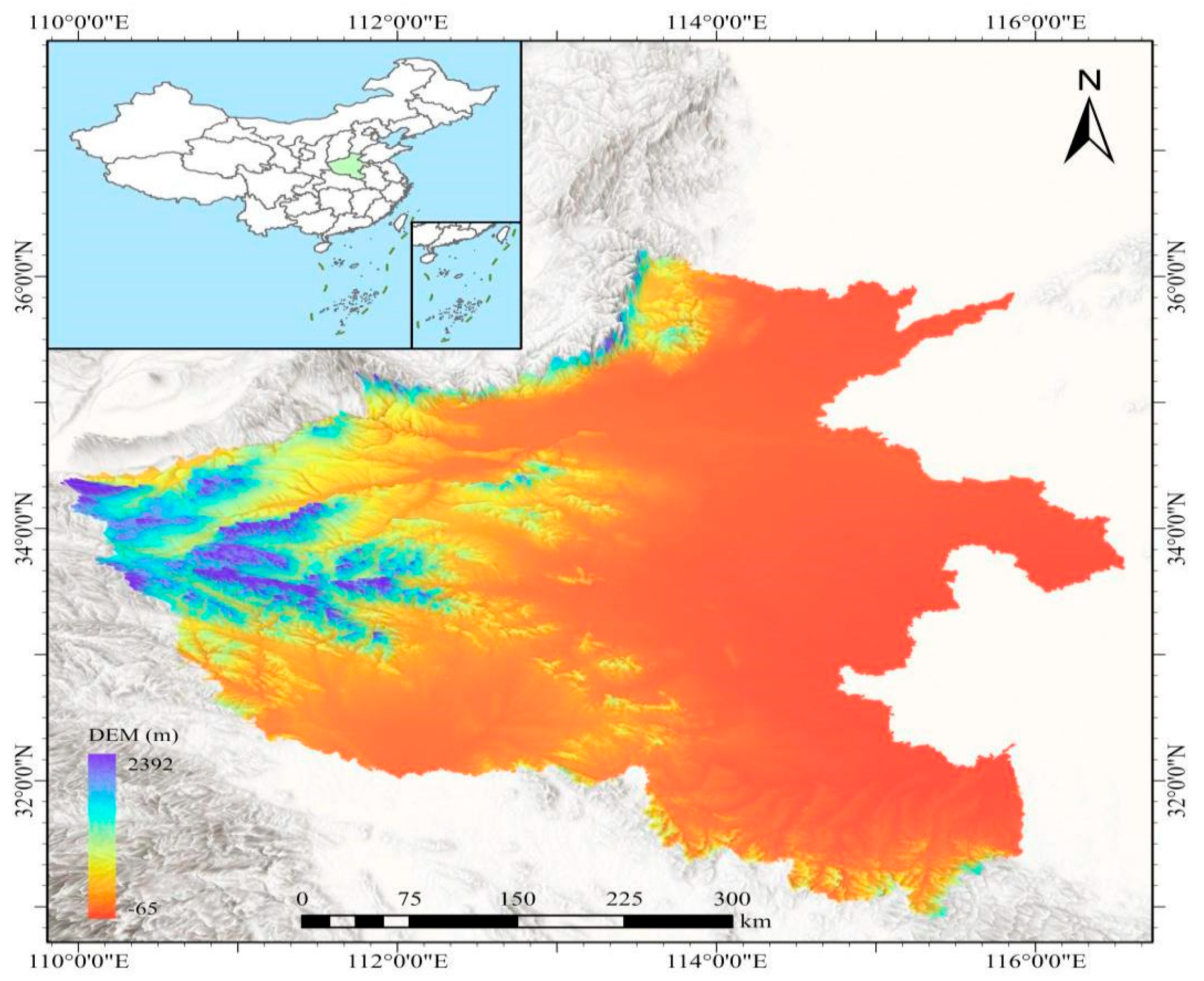
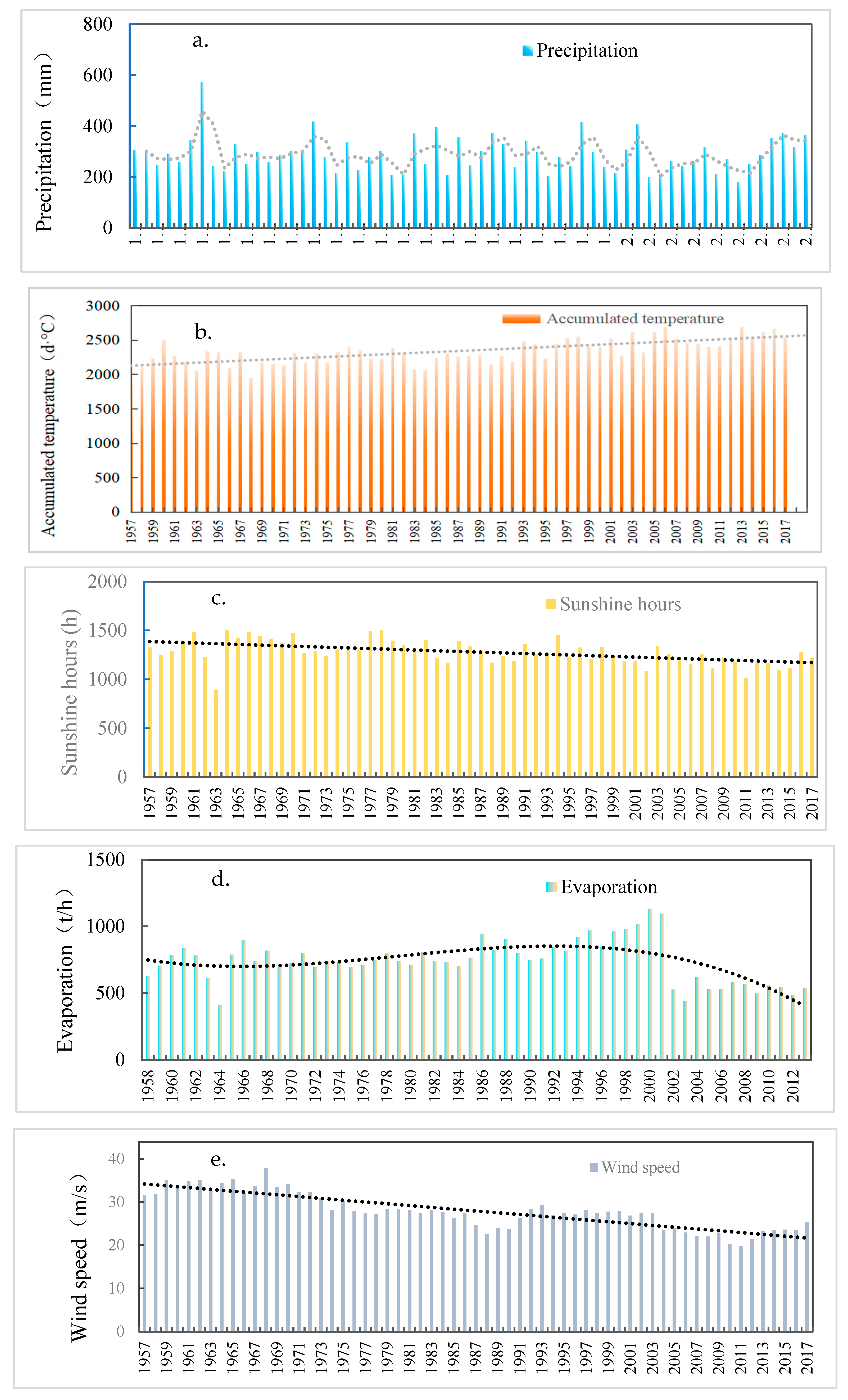
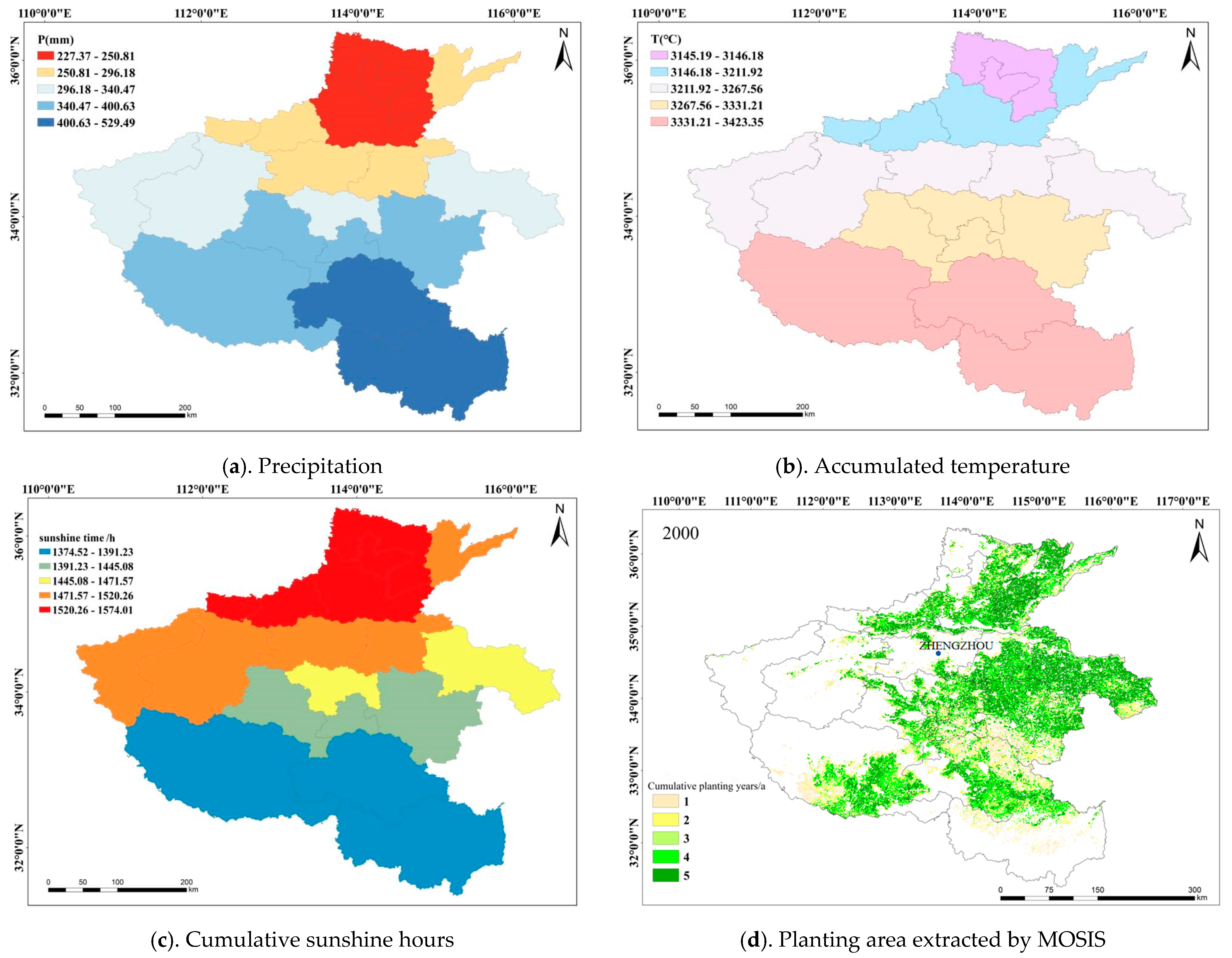

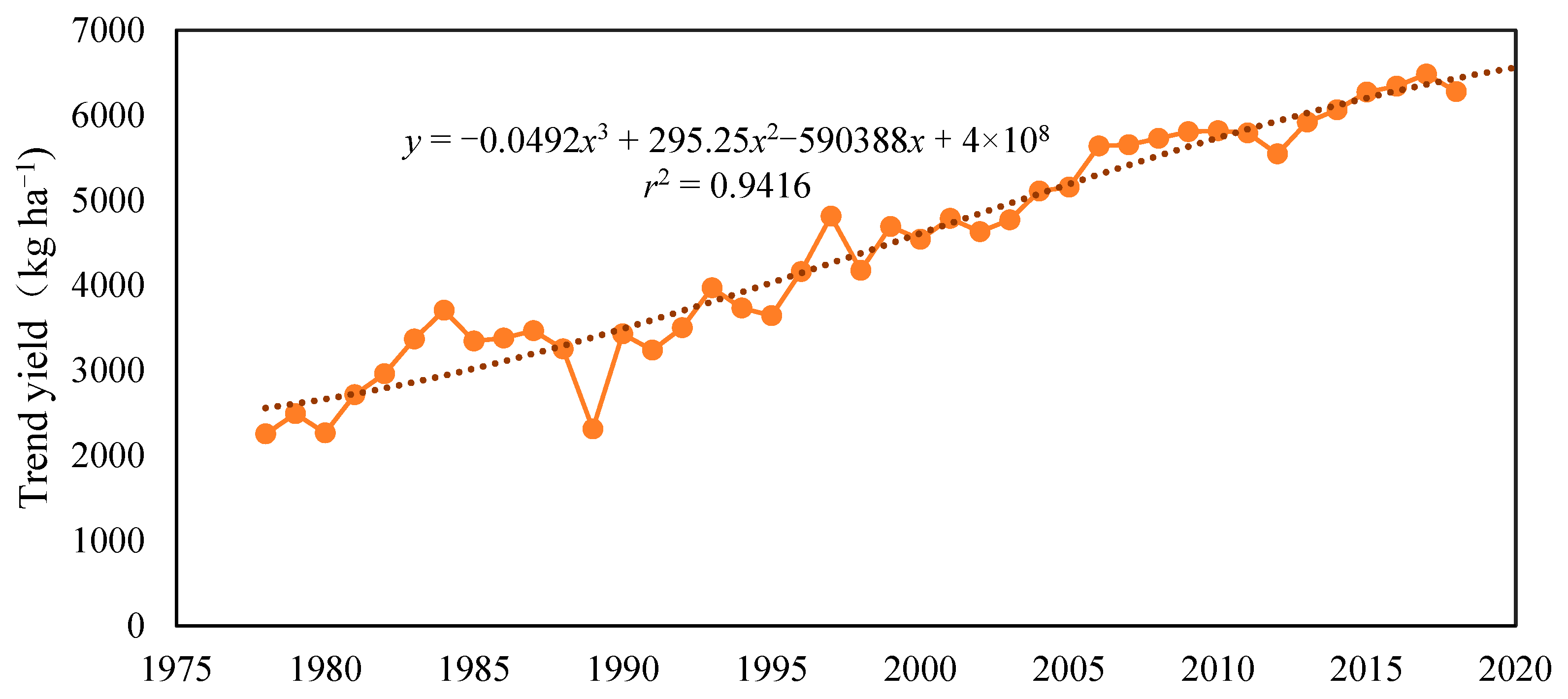
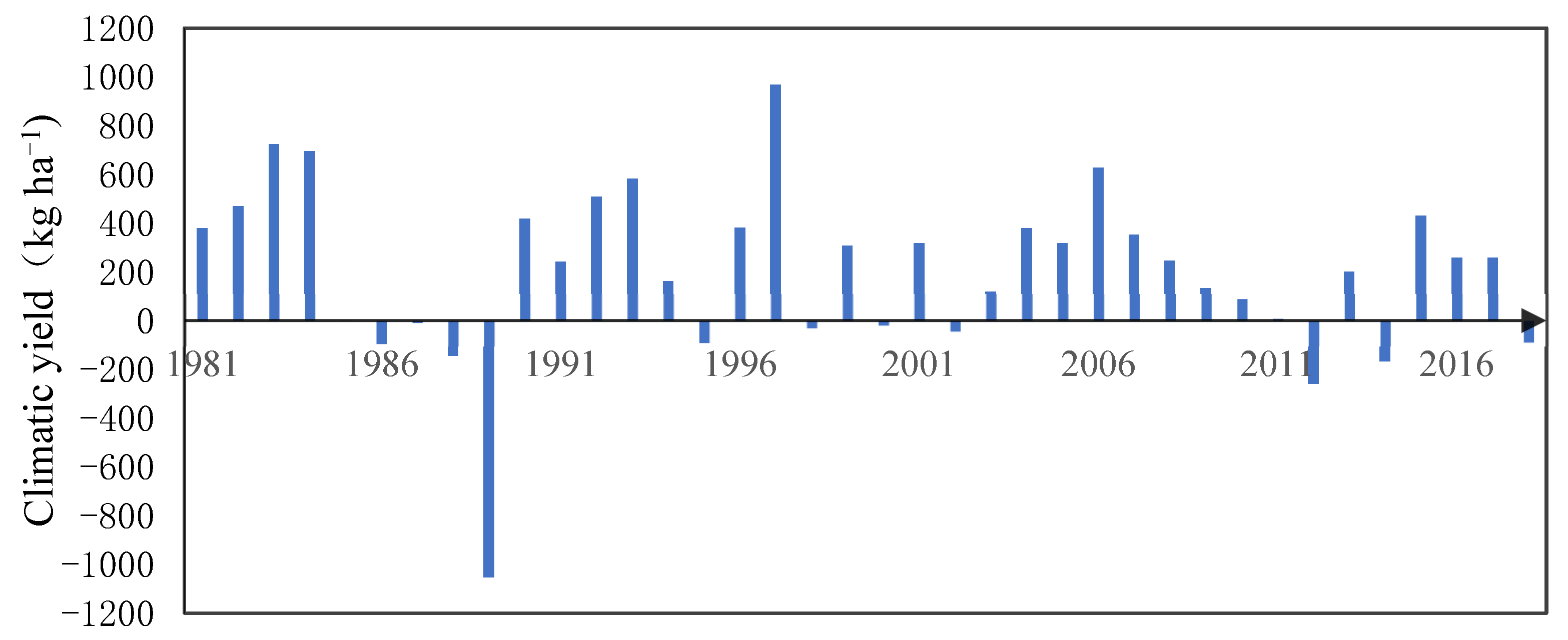
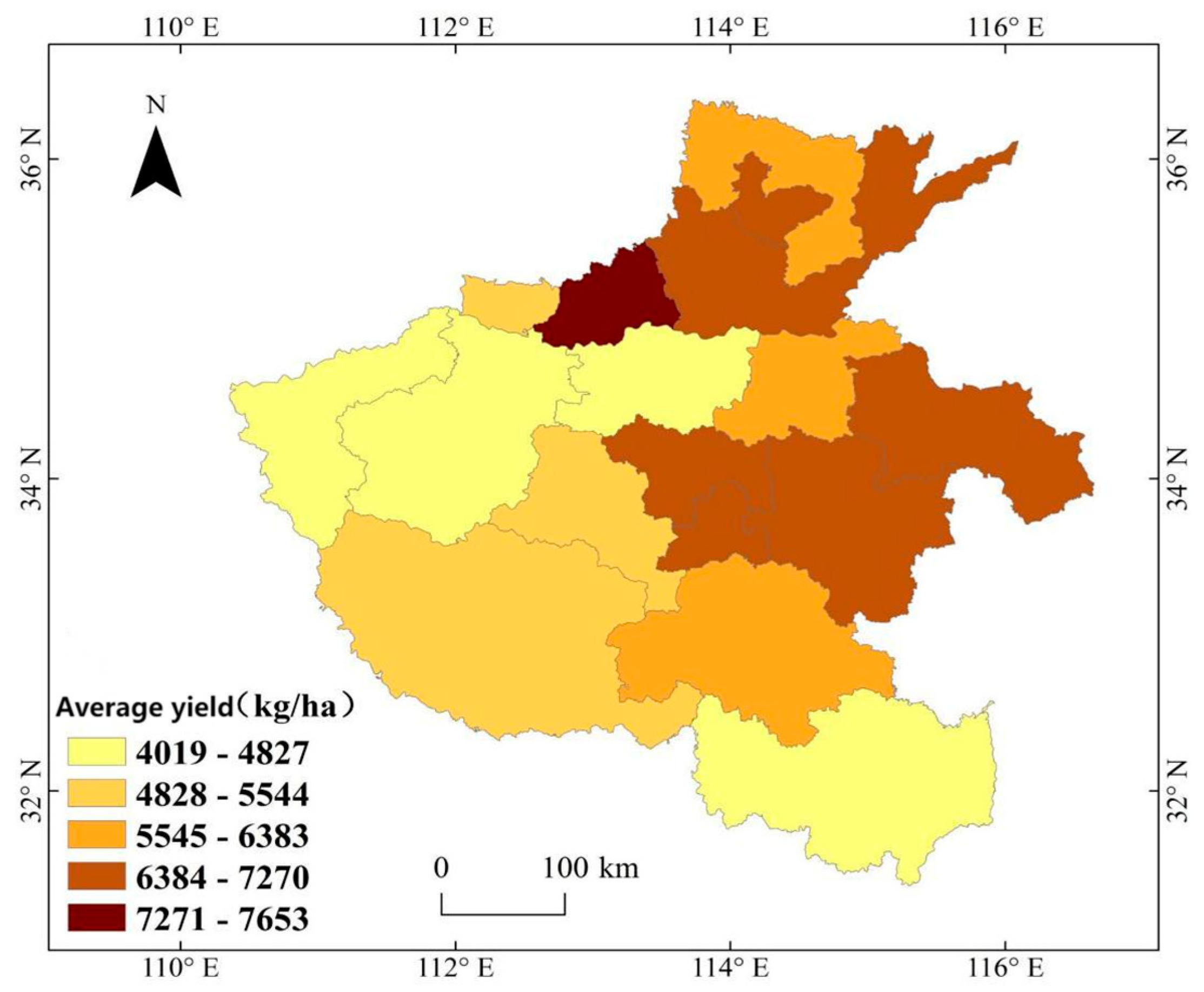
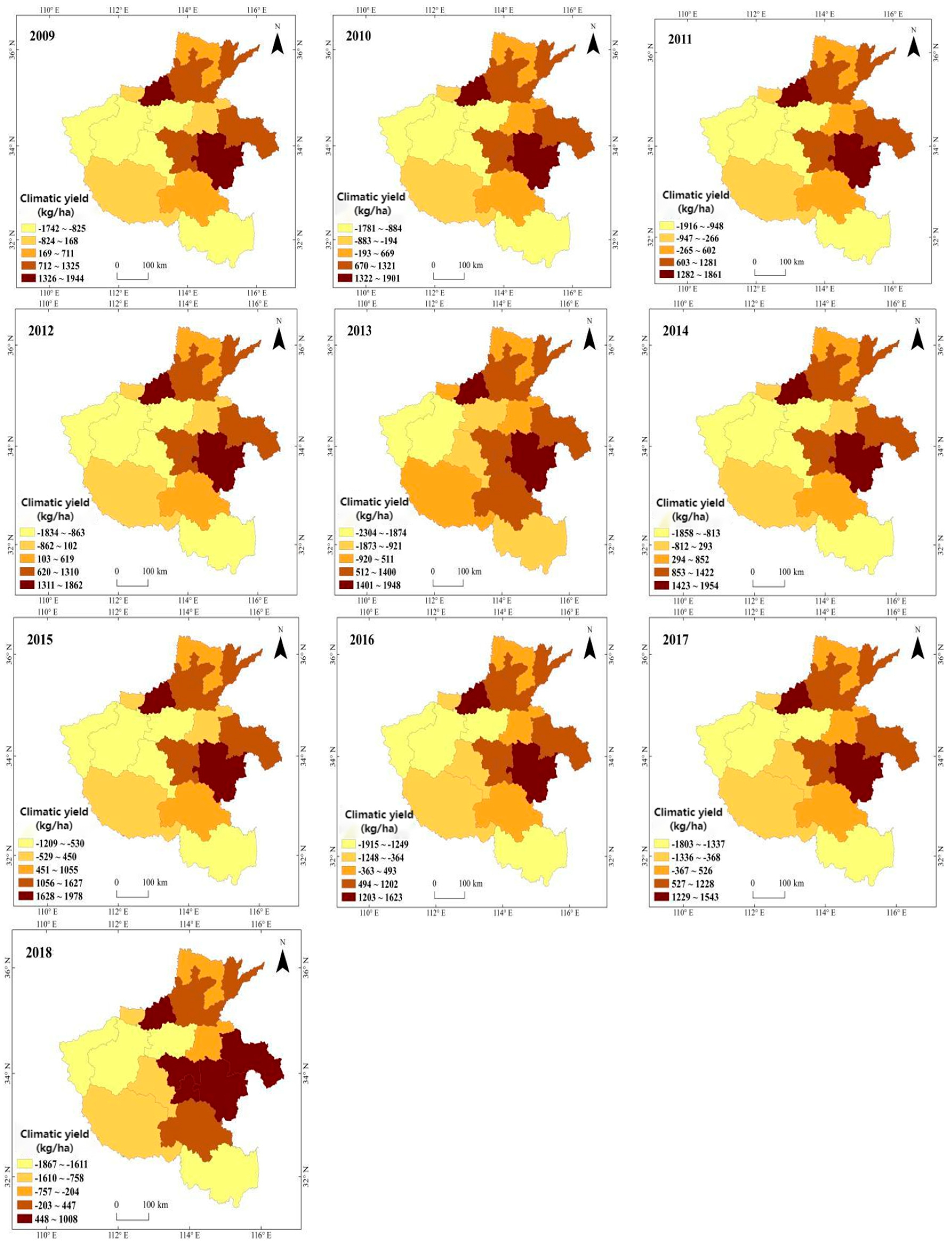



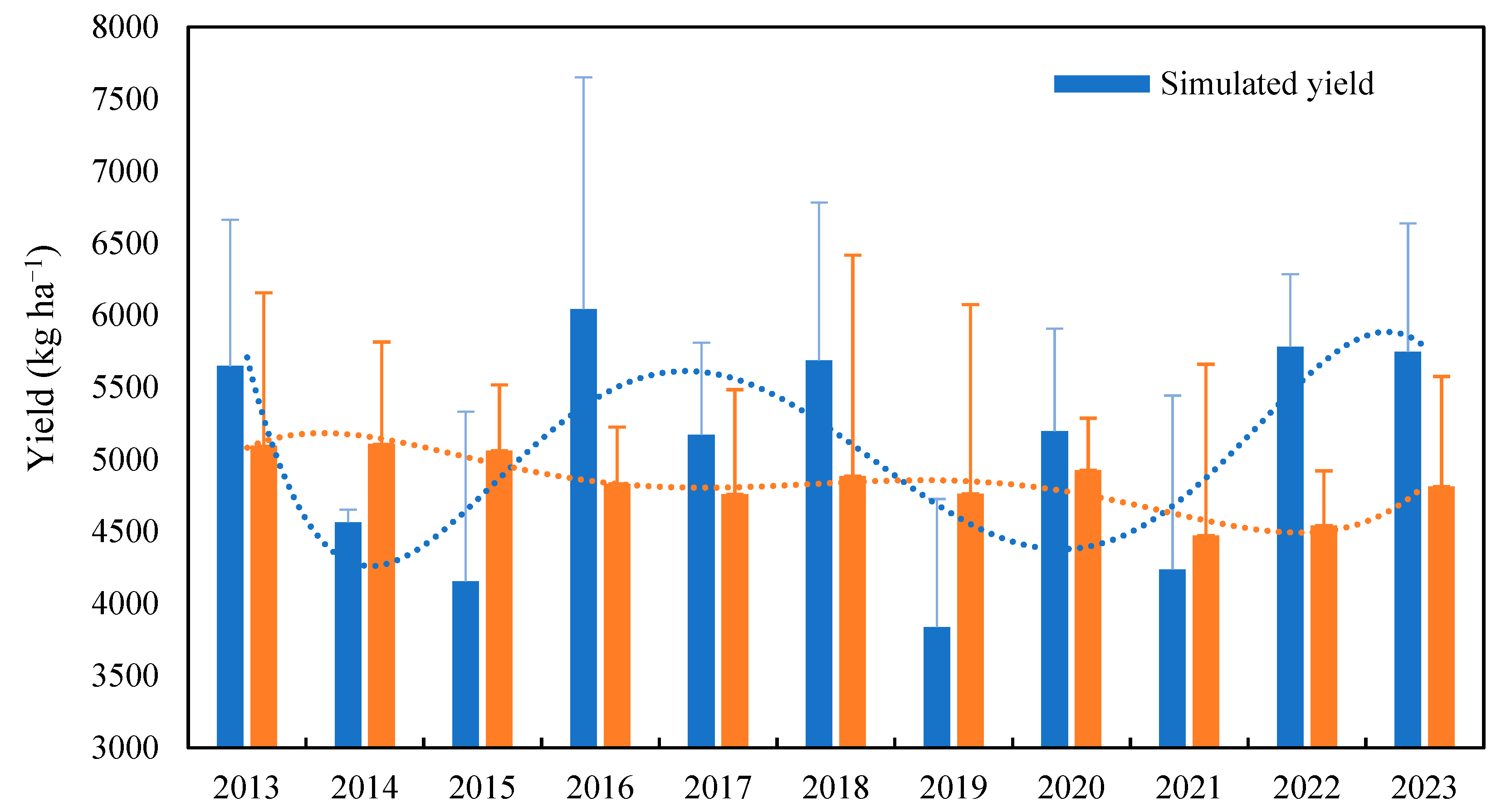
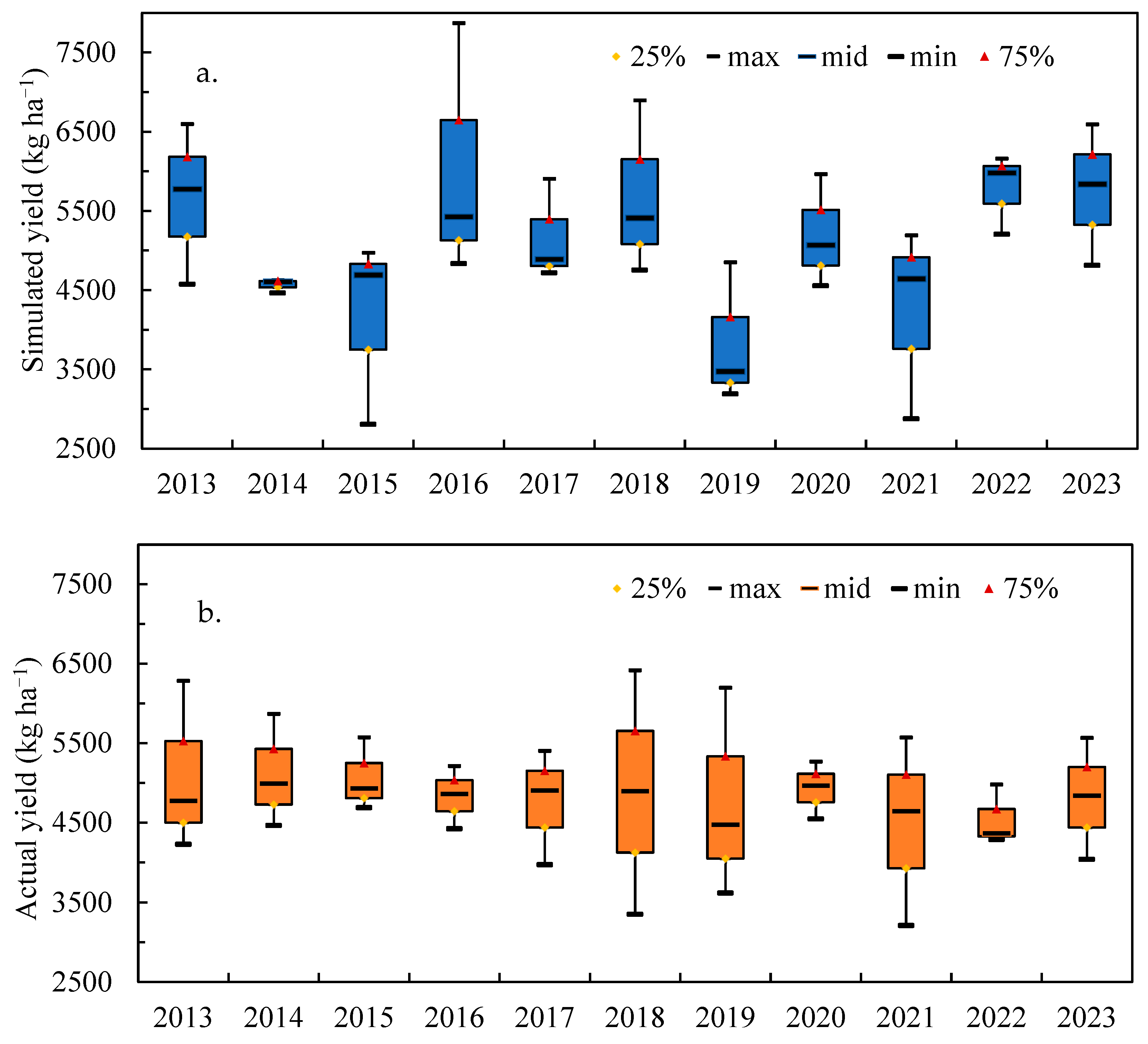
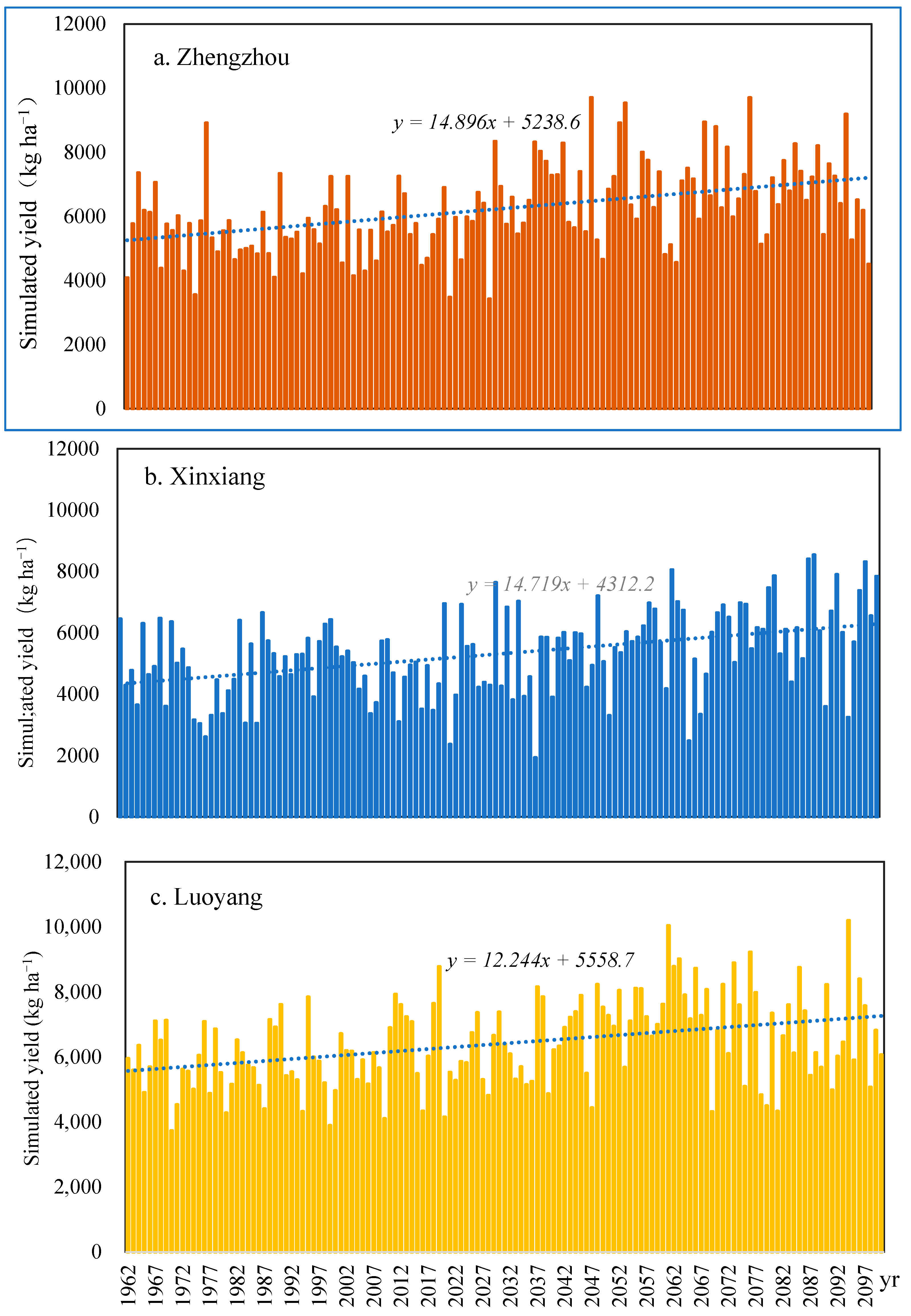
| Parameters | Definition | Value |
|---|---|---|
| Vern_Sens | Vernalization index | 3.0 |
| Pohtop_sens | Photoperiodic index | 3.5 |
| tt_start_grain_fill | Accumulated temperature during the filling period | 800 |
| tt_flowering | Accumulated temperature during the flowering period | 120 |
| tt_floral_initiation | Accumulated temperature during the initial flowering period | 400 |
| tt_end_of_juvenile | The accumulated temperature from emergence to jointing | 500 |
| max_grain_size | Maximum grain weight | 0.043 |
| grains_per_gram_stem | The weight of grains per stem | 15 |
| Experiment Sites | Crop Season | Cultivars | Fertilizer (kg N ha−1) | Irrigation (mm ha−1) | Sowing Date | Harvest Date | Seeding Density (kg ha−1) | |
|---|---|---|---|---|---|---|---|---|
| Zhengzhou | Calibration | 2022–2023 | Jiman22 | 180 | 45 | 30-Sep | 5-Jun | 300 |
| Validation | 2022–2024 | Jiman22 | 180 | 45 | 17-Oct | 30-May | 300 | |
| Luoyang | Calibration | 2018–2029 | Luomai26 | 180 | 45 | 8-Oct | 3-Jun | 300 |
| Validation | 2022–2024 | Luomai26 | 180 | 45 | 9-Oct | 9-Oct | 300 | |
| Xinxiang | Calibration | 2013–2014 | Zhongmai578 | 180 | 45 | 12-Oct | 13-Jun | 225 |
| Validation | 2016–2018 | Zhongmai578 | 180 | 45 | 17-Oct | 8-Jun | 225 |
| Soil Depth (cm) | Soil Physical Properties | Soil Particle Composition | |||||||
|---|---|---|---|---|---|---|---|---|---|
| Soil Volume (g/cm3) | Field Capacity (cm3/cm3) | Nitrate Nitrogen (mg/cm3) | Ammonium Nitrogen (mg/cm3) | Soil Organic Matter (g·kg−1) | Total N (g·kg−1) | Sandy (%) | Soil (%) | Clay (%) | |
| 0~20 | 1.35 | 32 | 0.0368 | 0.0104 | 9.16 | 0.5665 | 0.17 | 0.64 | 0.19 |
| 20~40 | 1.56 | 34 | 0.0204 | 0.0033 | 6.67 | 0.3635 | 0.11 | 0.65 | 0.24 |
| 40~60 | 1.41 | 34 | 0.0132 | 0.0018 | 2.79 | 0.1945 | 0.09 | 0.65 | 0.26 |
| Factors | q |
|---|---|
| Precipitation | 0.340 |
| Soil type | 0.136 |
| Accumulated temperature | 0.548 |
| Wind speed | 0.208 |
| Sunshine hours | 0.261 |
| Humidity | 0.226 |
Disclaimer/Publisher’s Note: The statements, opinions and data contained in all publications are solely those of the individual author(s) and contributor(s) and not of MDPI and/or the editor(s). MDPI and/or the editor(s) disclaim responsibility for any injury to people or property resulting from any ideas, methods, instructions or products referred to in the content. |
© 2025 by the authors. Licensee MDPI, Basel, Switzerland. This article is an open access article distributed under the terms and conditions of the Creative Commons Attribution (CC BY) license (https://creativecommons.org/licenses/by/4.0/).
Share and Cite
Wang, D.; Sun, T.; Li, Y.; Zhang, H.; Li, Z.; Liu, S.; Dong, Q.; Li, Y. Quantifying the Spatiotemporal Response of Winter Wheat Yield to Climate Change in Henan Province via APSIM Simulations. Agriculture 2025, 15, 2059. https://doi.org/10.3390/agriculture15192059
Wang D, Sun T, Li Y, Zhang H, Li Z, Liu S, Dong Q, Li Y. Quantifying the Spatiotemporal Response of Winter Wheat Yield to Climate Change in Henan Province via APSIM Simulations. Agriculture. 2025; 15(19):2059. https://doi.org/10.3390/agriculture15192059
Chicago/Turabian StyleWang, Donglin, Tielin Sun, Yijie Li, Hanglong Zhang, Zongyang Li, Shaobo Liu, Qinge Dong, and Yanbin Li. 2025. "Quantifying the Spatiotemporal Response of Winter Wheat Yield to Climate Change in Henan Province via APSIM Simulations" Agriculture 15, no. 19: 2059. https://doi.org/10.3390/agriculture15192059
APA StyleWang, D., Sun, T., Li, Y., Zhang, H., Li, Z., Liu, S., Dong, Q., & Li, Y. (2025). Quantifying the Spatiotemporal Response of Winter Wheat Yield to Climate Change in Henan Province via APSIM Simulations. Agriculture, 15(19), 2059. https://doi.org/10.3390/agriculture15192059






